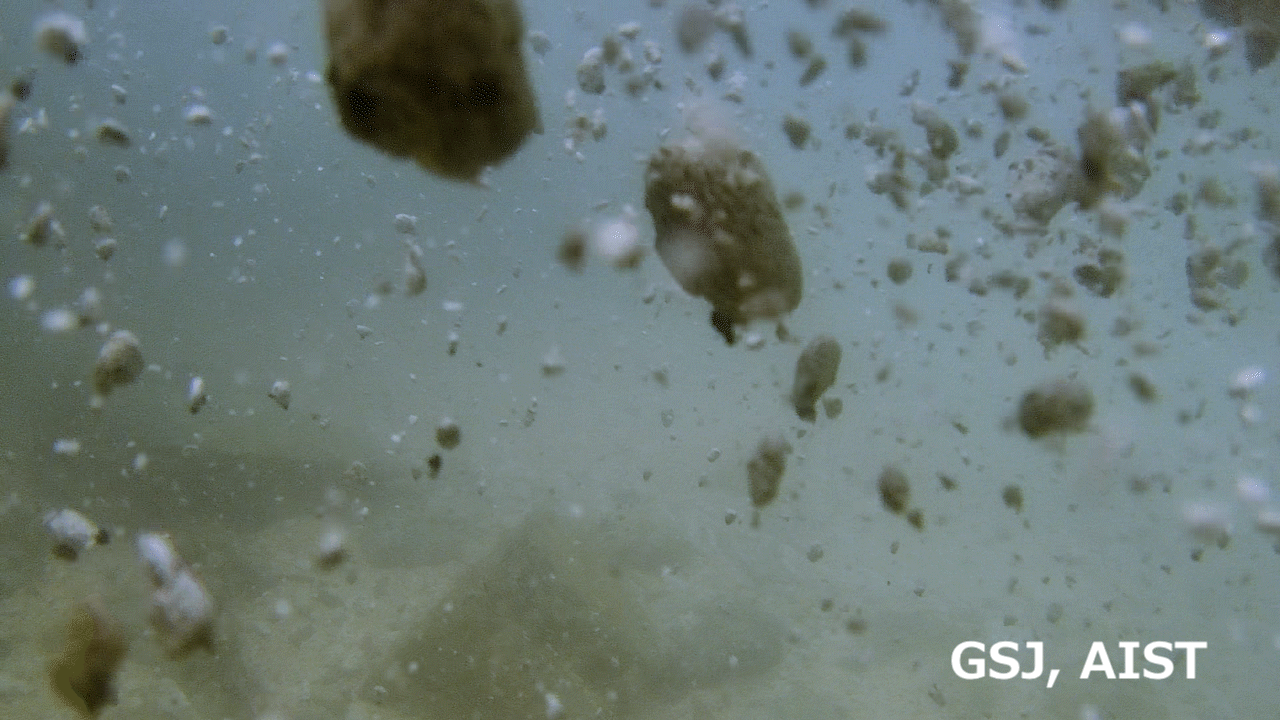Fukutoku-Oka-no-Ba submarine volcano information top
Release date: October 27, 2021 (JST)
Status and impacts of pumice rafts around Okinawa Island(Part 1)
AIST researchers conducted a field survey to determine the status of the pumice rafts in the Motobu Peninsula on the western side of the main island of Okinawa and in Kunigami Village on the northern tip (Photo 1). The survey was conducted on October 18 and 19, 2021. On the northern coast of Motobu Peninsula and the eastern coast of Kunigami Village, large amounts of pumice had been washed ashore, but several relatively small pumice rafts remained drifting offshore or were stalled from reaching the shore by coral reefs at this time (Photos 2 and 3).
Most of the pumice clasts that have washed ashore have a major axis length of 3 mm to 3 cm, but some pumice stones exceed 10 cm in length. The maximum length was about 25 cm. Along the shoreline where pumice was being washed onto land, the thickness of the layered pumice floating on the sea surface was about 10 cm (Photo 4), and the rafts floating a little offshore were about 3 to 5 cm thick. However, several pumice stones floating under the sea surface were also recognized (Photo 5).
When conducting observations at low tide, pumice clasts that have been washed up on the beach during high tide from thick deposits along the ridge of the foreshore, while the low tide mark deposits are thin, and the pumice accumulations are thick again at the shoreline (Photo 6).
If a large amount of pumice is washed ashore, it is expected that power plants, steelworks, and combustion engines of ships that use shallow seawater as cooling water will be damaged. In fact, in the Ryukyu Islands, fishing boats and ferries have suspended operations due to widespread and thick accumulations of pumice along the coasts. There is a concern that the pumice that has settled on the beach will be remobilized in the sea due to changes in the tide level or high waves during a storm. Furthermore, satellite images show larger pumice rafts further offshore, so a large amount of pumice is expected to continue drifting and washing ashore for some time. Therefore, widespread disruption and damage is expected to be ongoing.
Photo 1 AIST researcher observing pumice being deposited at Uppama Beach in Nakijin Village, Okinawa Prefecture on October 18. In the background, many pumice clasts can be seen on the surface of the sea that continue to drift ashore.
Photo 2 Pumice raft reaching the shore at Uppama Beach, Nakijin Village, Okinawa Prefecture, on the afternoon of October 18, 2021. It took about two months to drift 1300 km from Fukutoku-Oka-no-ba.
Photo 3 A pumice raft of about 500 square meters was observed to have been blocked along the offshore reef.October 19, near the mouth of the Ie River in Sosu, Kunigami Village, Okinawa Prefecture.
Photo 4 Pumice raft washing ashore near Ibu Beach, Kunigami Village, Okinawa Prefecture on October 19. An AIST researcher is shown in the upper right of the photo.
Photo 5 Slow motion GIF video with a playback speed of 25% of pumice clasts floating below the surface of the sea. The pumice in the center is about 5 cm in diameter. October 19, Ibu Beach, Kunigami Village, Okinawa Prefecture.
Photo 6 Pumice clasts deposited at high tide have formed thick accumulations on beaches at the northern tip of the main island of Okinawa. October 19, Ibu Beach, Kunigami Village, Okinawa Prefecture.
IEVG (Research Institute of Earthquake and Volcano Geology)







